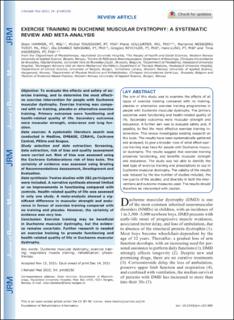| dc.contributor.author | Hammer, Stian | |
| dc.contributor.author | Toussaint, Michel | |
| dc.contributor.author | Vollsæter, Maria | |
| dc.contributor.author | Tvedt, Marianne Nesbjørg | |
| dc.contributor.author | Røksund, Ola Drange | |
| dc.contributor.author | Reychler, Gregory | |
| dc.contributor.author | Lund, Hans | |
| dc.contributor.author | Andersen, Tiina Maarit | |
| dc.date.accessioned | 2022-08-18T13:36:08Z | |
| dc.date.available | 2022-08-18T13:36:08Z | |
| dc.date.created | 2022-04-30T14:42:37Z | |
| dc.date.issued | 2022 | |
| dc.identifier.issn | 1650-1977 | |
| dc.identifier.uri | https://hdl.handle.net/11250/3012576 | |
| dc.description.abstract | Objective: To evaluate the effects and safety of exercise training, and to determine the most effective exercise intervention for people with Duchenne muscular dystrophy. Exercise training was compared with no training, placebo or alternative exercise training. Primary outcomes were functioning and health-related quality of life. Secondary outcomes were muscular strength, endurance and lung function.
Data sources: A systematic literature search was conducted in Medline, EMBASE, CINAHL, Cochrane Central, PEDro and Scopus.
Study selection and data extraction: Screening, data extraction, risk of bias and quality assessment were carried out. Risk of bias was assessed using the Cochrane Collaborations risk of bias tools. The certainty of evidence was assessed using Grading of Recommendations Assessment, Development and Evaluation.
Data synthesis: Twelve studies with 282 participants were included. A narrative synthesis showed limited or no improvements in functioning compared with controls. Health-related quality of life was assessed in only 1 study. A meta-analysis showed a significant difference in muscular strength and endurance in favour of exercise training compared with no training and placebo. However, the certainty of evidence was very low.
Conclusion: Exercise training may be beneficial in Duchenne muscular dystrophy, but the evidence remains uncertain. Further research is needed on exercise training to promote functioning and health-related quality of life in Duchenne muscular dystrophy. | en_US |
| dc.language.iso | eng | en_US |
| dc.publisher | Foundation for Rehabilitation Information | en_US |
| dc.rights | Navngivelse-Ikkekommersiell 4.0 Internasjonal | * |
| dc.rights.uri | http://creativecommons.org/licenses/by-nc/4.0/deed.no | * |
| dc.title | Exercise Training in Duchenne Muscular Dystrophy: A Systematic Review and Meta-Analysis | en_US |
| dc.type | Journal article | en_US |
| dc.type | Peer reviewed | en_US |
| dc.description.version | publishedVersion | en_US |
| dc.rights.holder | Copyright 2021 Stian Hammer | en_US |
| dc.source.articlenumber | jrm00250 | en_US |
| cristin.ispublished | true | |
| cristin.fulltext | original | |
| cristin.qualitycode | 1 | |
| dc.identifier.doi | 10.2340/jrm.v53.985 | |
| dc.identifier.cristin | 2020341 | |
| dc.source.journal | Journal of Rehabilitation Medicine | en_US |
| dc.identifier.citation | Journal of Rehabilitation Medicine. 2022, 54, jrm00250. | en_US |
| dc.source.volume | 54 | en_US |

